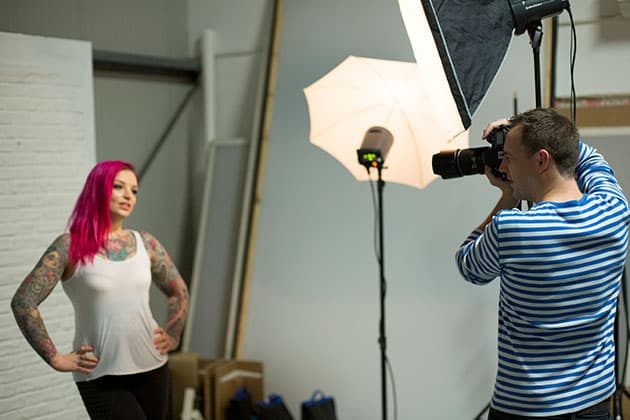
Credit: James Paterson
Whether you want to shoot portraits, pets, products, food or macro, a studio lighting kit will lend your photos a level of clarity and professionalism that is difficult to achieve in any other way. It opens the door to complete control. If you’re new to studio lighting, then get ready to fall in love with photography all over again.
However, studio flash can initially seem slightly daunting. There are so many decisions to make: which exposure settings should I use? Where do I position my lights? Which modifiers would be best? And which flash power should I use? These are all stumbling blocks that can be overcome with a little know-how. Over the following pages we’ll shed some light on the subject.
Monoblock or strobe?
The jargon around flashes can be a little confusing: are they studio heads, monoblocks, monolights, power packs or strobes? In general, a starter kit will include two monoblocks (or ‘monolights’ for those in the USA). These are individual, self-contained flash units that plug into the mains. By contrast, a power pack is a sort of control centre for running multiple smaller lights, while ‘strobe’ is a catch-all term for any type of flash. As well as the two monoblocks, a starter kit will typically include two stands, a sync cable/wireless trigger and light modifiers like white umbrellas, silver umbrellas or softboxes. These modifiers are key to succeeding with flash. They let us diffuse and control the spread of light for all kinds of looks.
If the kit doesn’t have a wireless trigger we’d recommend getting one. Flash sync cables are fiddly, they always seem to fall out of the camera at the wrong moment, and they’re easy to trip over. What’s more, many cameras won’t even have a sync cable socket. Wireless triggers are cheap and make things easier. One other piece of kit that comes in very handy – and that many of us will have already – is a reflector. Positioned opposite the flash, we can use the reflector to bounce light back into the shadows and reduce the contrast. As such, it can act almost like another separate light.

Most studio units will have modelling lights. Credit: James Paterson
How much power do you need?
If you’re considering getting a starter kit, then the first decision is all about power. The power of a flash head is measured in watt-seconds (the maximum number of watts that can be output over 1 second). Studio strobes typically start at around 100W for the cheaper models, and can go up to 1200W for expensive, high-output heads. The right level of power for you will depend on what you shoot – if you need to light a huge space or big group of people, then 800W might be necessary, but for a home studio portrait set-up where you’ll mostly be shooting individuals or small groups, then you’re unlikely to need more than 300W strobes.
Compared to a speedlight, even the lowest power monoblocks will be at least double the strength. There are other practical advantages too. Mains power means there’s no need for batteries, recycling times are much quicker and light modifiers are easy to use. What’s more, studio units have helpful modelling lights. These are constant lights that help us to visualise the play of light and shade across our subject before we take the shot.
Controlling the flash
A studio flash head will usually offer a few simple controls. First, there’s the output setting. This controls the strength of the light. Many monoblocks have a range between 1.0 and 6.0. Each number represents one stop of light, so the maximum output of 6.0 could equally be thought of as 1/1 power, while the minimum output of 1.0 is effectively 1/32 power (although some heads will go lower than this). Of course, the strength of this maximum and minimum output will vary depending on the power of the unit and whether a light modi er is fitted.
Among the other controls there’s usually a button that switches the recycling beep on or off. This tells us when the heads are fully recycled and ready to fire (it usually takes half a second or so). The other useful control is an optical slave mode. Enable this on our second light and it’ll fire upon detecting the flash from the first.
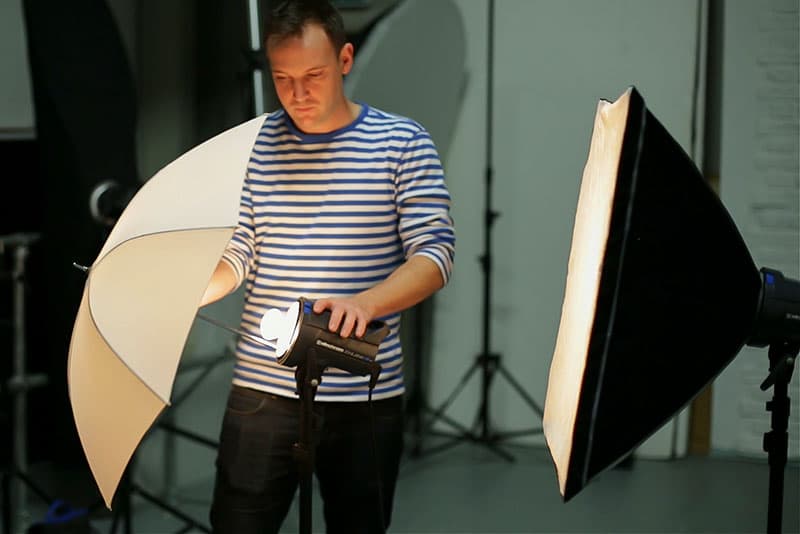
Starter kits typically include both an umbrella and softbox. Credit: James Paterson
Why use studio lighting?
The main reasons to use studio lighting are quality and control. The power of the flash means we can shoot with a low ISO for maximum quality with minimal noise. The second reason is the control that studio lighting offers. There’s control over the positioning of the lights – we can place them above, below, in front, behind – wherever we choose. Then there’s the control we have over exposure. We dictate the exposure; we don’t have to let the lights dictate it for us.
As photographers we are used to adapting our exposure settings to suit the available light, so using studio lighting is a slight shift in mindset. We can, with a few exceptions, choose whatever combination of shutter speed, aperture and ISO we want. If you’re just getting started, then here’s a stock exposure setting to begin with. In manual exposure mode choose a shutter speed of 1/200sec (which is usually around the maximum flash sync speed for a DSLR), then set aperture f/8 and ISO 100. Turn on the flash and take a few test shots. If the image comes out too bright or too dark then simply adjust the power of the light – either by moving it closer or further away, or by changing the output – until you have a correct exposure.
You can also use a light meter to determine the right flash power, or simply judge it by assessing the histogram on the camera’s LCD.
One light or two?
While it might be tempting to use both monoblocks in a starter kit, if you’re new to studio lighting then start with just one. Get to grips with positioning, power and exposure; and then when you’re comfortable with one light progress to using two. Whenever we use more than one flash, it can be a very helpful exercise to ‘build’ the lighting by taking test shots of each light in isolation, with all the others off. This way, we can see exactly how each affects the overall set-up, which makes it much easier to strike a harmonious balance between them. Get to grips with this, and the possibilities for beautifully controlled lighting are endless.
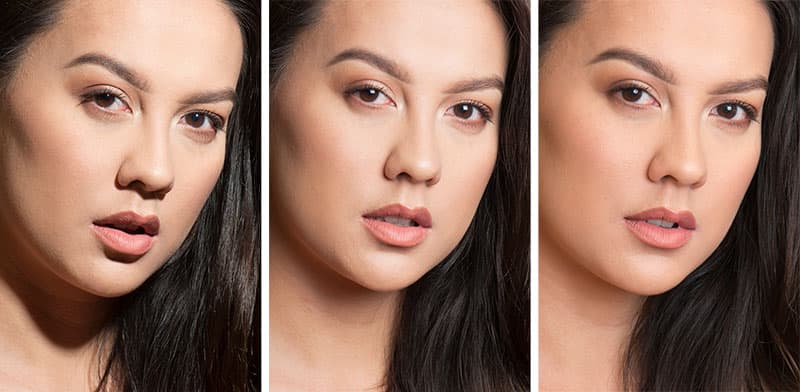
Bare bulb (left), Softbox (middle) and Umbrella (right). Credit: James Paterson
Bare bulb vs softbox vs umbrella
A key reason to use studio lighting is the many options we have to change the quality of the light using a variety of modifiers. A starter kit will typically include a softbox and umbrella, and we also have the option to fire the flash bare. When fired bare, the light source is very small and, like the midday sun in a cloudless sky, light from a small source is very hard-edged. Note here (left) how it creates deep shadows under the chin. By contrast, when we modify the light with an umbrella or softbox we increase the size of the source so the light is more diffuse and the shadows become much softer. The softbox is arguably the winner here, because the shadows are soft but still nicely defined. It’s harder to control the spread of light with an umbrella, therefore it’s bounced off all the nearby walls and surfaces here and filled in the shadows, resulting in less contrast.
10 tips for flash photography
- Distance affects power Halving the distance between the ash and subject will increase its strength by four times – or two stops – in accordance with the inverse square law.
- Distance and quality Changing the distance of the light also changes its size in relation to the subject – the further away it is, the harder the quality of light.
- Watch for fall-off The fall-off of a flash is the difference in strength across the subject, and it will be more pronounced if the light is in very close.
- Look to the catchlights If you want to see how other portrait photographers have lit their photos, the catchlights in the subject’s eyes can indicate the positioning, quantity and type of light used.
- Bounce the flash As well as using modifiers like umbrellas and softboxes, remember that you can also soften and diffuse the light by bouncing it off the walls or ceiling.
- Shutter speed and flash Shutter speed has no bearing on the ash exposure, only on the influence of the ambient light. If in doubt, stick to 1/200sec.
- Diffusion needs more power Any modifier placed between our light source and the subject – like an umbrella or softbox – will weaken the output, so increase the power accordingly.
- Feather the light Try feathering the light by angling it across the front of the subject rather than directly at them; this gives an attractive ‘wrap-around’ quality.
- Recycle after lowering output If you lower the output, hit the test button to recycle the flash as it may still be primed for the previous higher power setting.
- Bring lights in close Bringing the lights in close will make them very large in relation to the subject and therefore produce softer, more flattering light.
The versatility of a single softbox

Credit: James Paterson
Lit from above
A single softbox can give us a wide variety of looks depending on the positioning and strength. Here it’s positioned directly above the face and angled downwards. This is sometimes called ‘butter y lighting’, as the shadow cast down from the nose looks a bit like a butterfly.
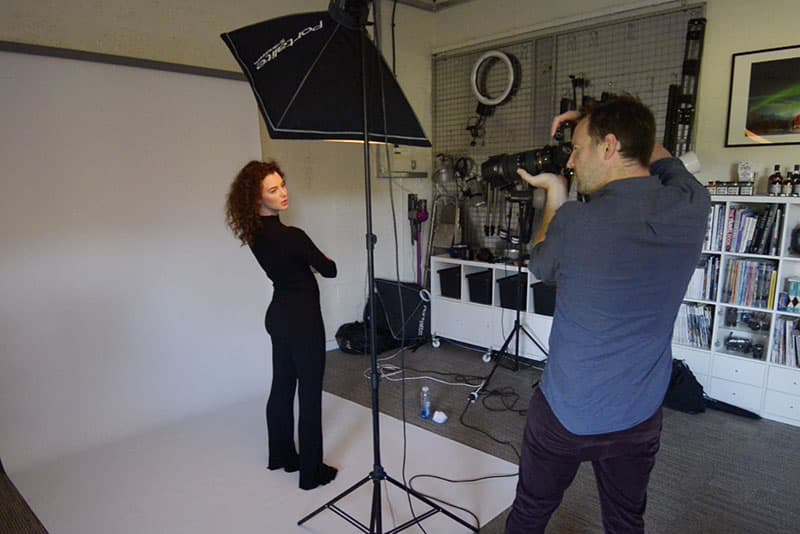
Credit: James Paterson
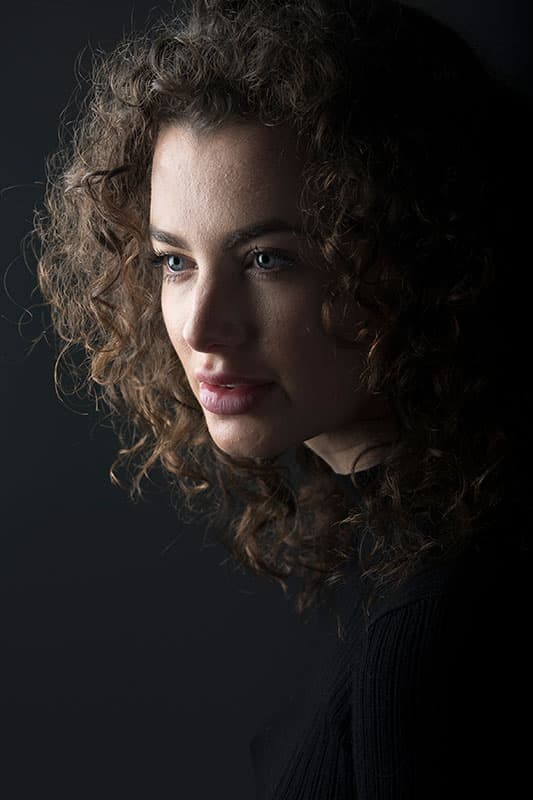
Credit: James Paterson
Backlighting
This time our softbox is positioned behind the subject to the left, lighting the far side of the face. Known as short lighting (as opposed to ‘broad’ which lights the front side), this gives a low-key, moody look. The background is very dark because our flash is angled away from it.
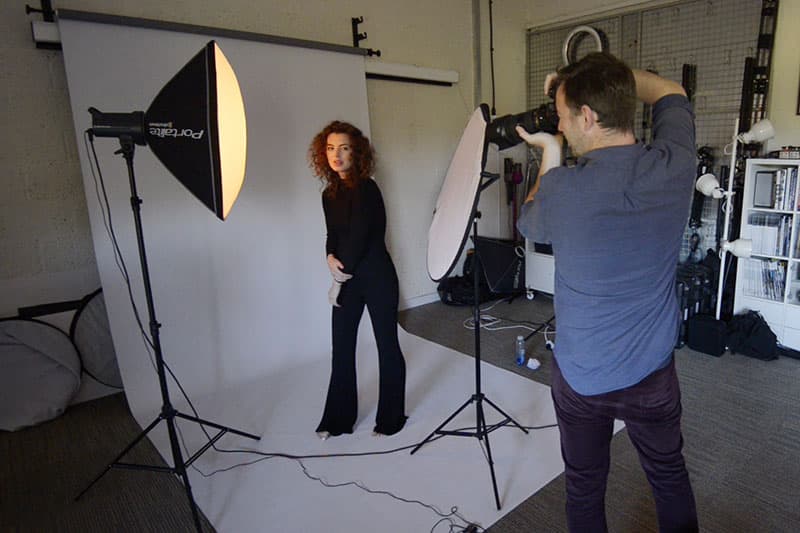
Credit: James Paterson
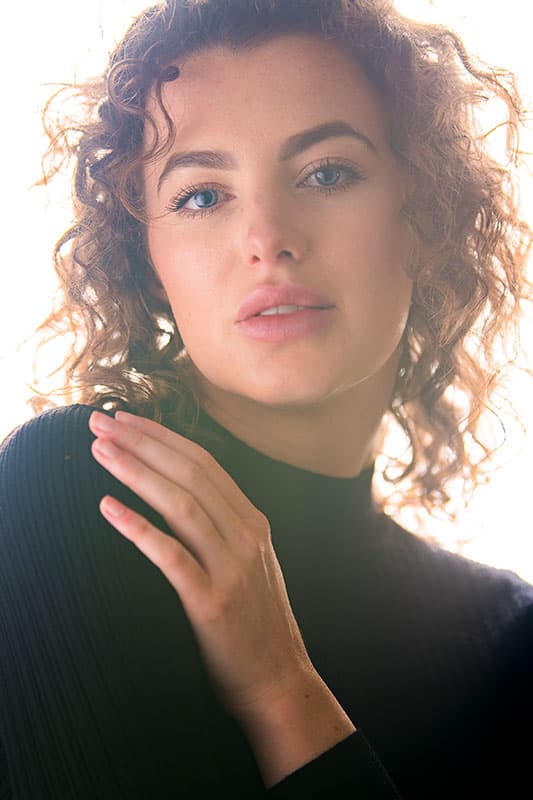
Credit: James Paterson
High-key
A softbox can act as a backdrop for a simple high-key look. The light will wrap around the edges of the face, creating attractive edge light along the cheeks. If the front of the face is too dark, it can be lifted by opening the aperture and bouncing light back in with a reflector.
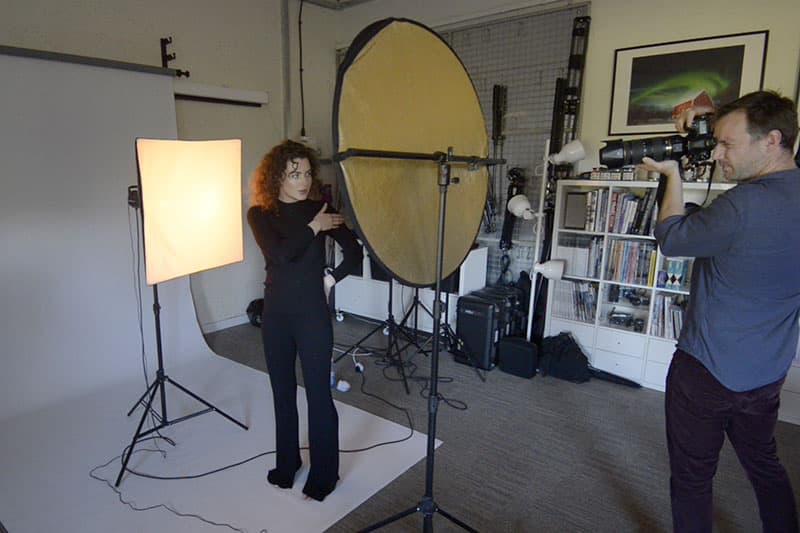
Credit: James Paterson

Credit: James Paterson
In silhouette
A similar high-key look to the previous shot, but this time our softbox is pointed at the backdrop instead. If we like, we can open up our aperture to lift the subject, or instead expose for the backdrop like this, so that they come out almost in silhouette.

Credit: James Paterson
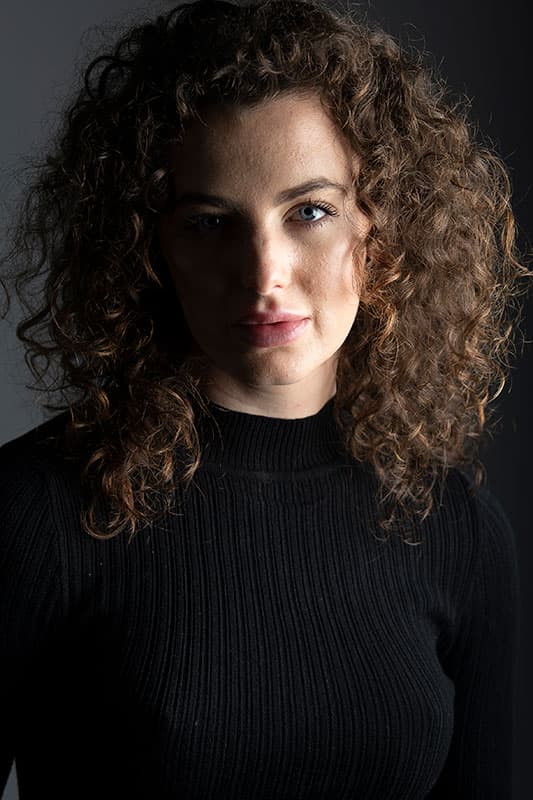
Credit: James Paterson
Side lighting
Here the light hits one side of the face, plunging the other into deep shadow. This is sometimes called ‘split lighting’. Note how the side-on light reveals much more texture in the skin than the frontal light in the first shot, resulting in a less-flattering portrait.

Credit: James Paterson

Credit: James Paterson
Under lighting
Placing the softbox underneath the chin gives us ‘scary movie’ lighting. We’re used to seeing light coming from above, so when it’s directed from below it can look unnatural – this holds true whether the subject is standing up like this or lying down.
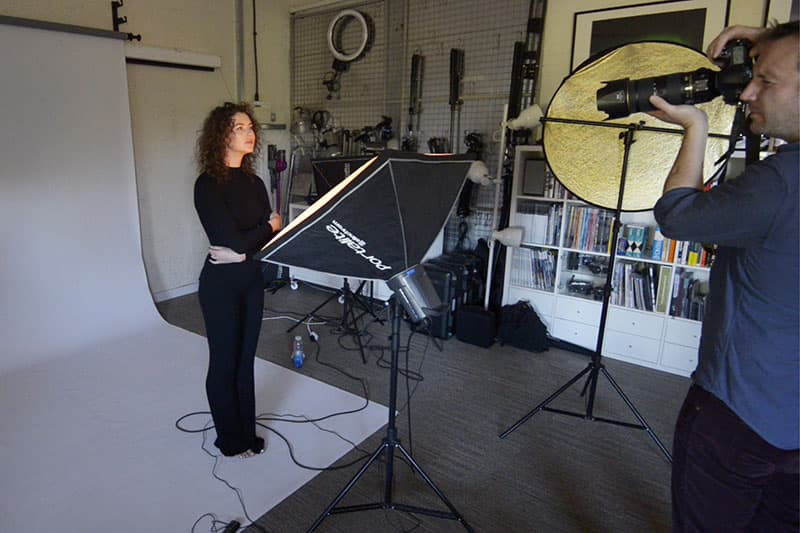
Credit: James Paterson
Kit list
- Monoblocks These are mains-powered flash units. More powerful than a speedlight, they also have modelling lights. Each light comes with a stand, and the fixtures on the front make it easy to fit light modifiers.
- Umbrella Diffuses and spreads the light. Either direct the flash through the umbrella, or angle it away and bounce light back off the umbrella. Useful for lighting interiors and portraits, but hard to control the spread of light.
- Softbox Softens and diffuses the light, much like window light. Creates attractive rectangular catchlights in the subject’s eyes. Similar to a white umbrella, but easier to control the play of light and shade.
- Sync cable/wireless trigger Attach this to your camera to trigger the flashes. All studio flash units will have an optical slave. This means if you trigger one flash, the others will detect it and fire too.

